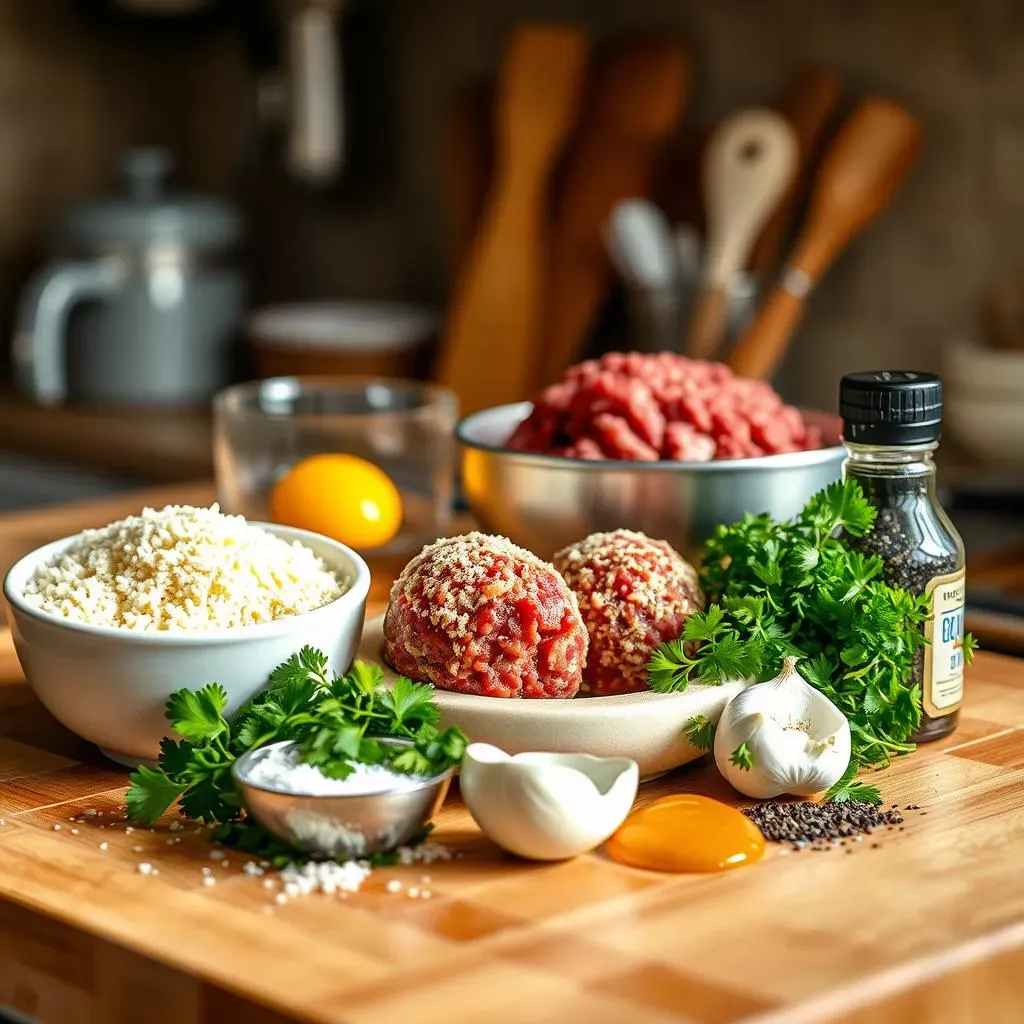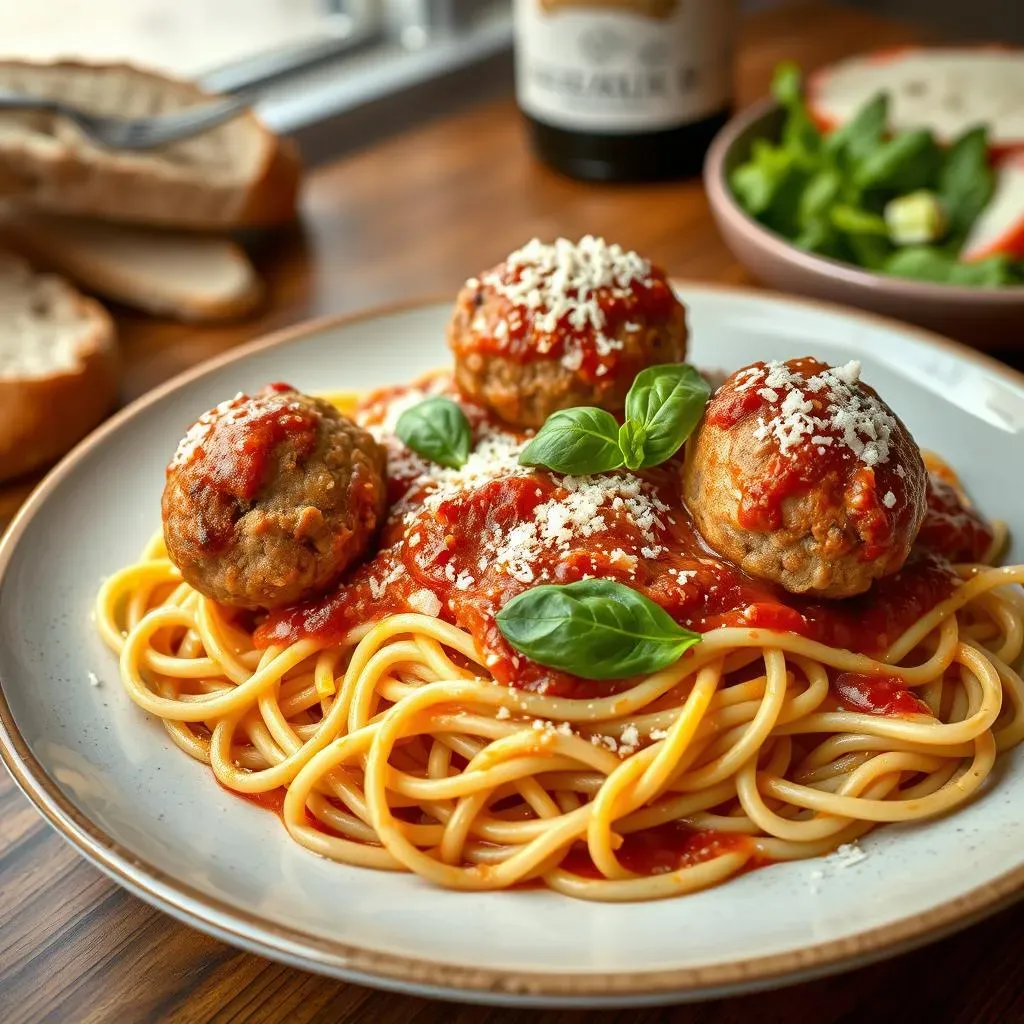Table of Contents
Ready to elevate your spaghetti night? Forget those dry, bland meatballs from a jar! This article delivers the ultimate guide to crafting juicy, flavorful ground beef meatballs, perfect for your favorite spaghetti. We'll walk you through everything, from selecting the best ingredients to mastering the art of meatball making and ensuring they're cooked to perfection. Get ready to impress your family and friends with a ground beef meatball recipe for spaghetti that's bursting with authentic Italian taste. We'll cover essential techniques for creating perfectly textured meatballs, offering tips and tricks to avoid common pitfalls. Whether you’re a seasoned cook or a kitchen novice, this step-by-step guide will empower you to create a restaurant-quality spaghetti and meatballs dish right in your own home. Prepare to discover the secrets to creating meatballs that are tender on the inside and delightfully browned on the outside, perfectly complementing your favorite spaghetti and sauce. Let's get cooking!
Gathering Your Ingredients: A Meatball Masterclass

Gathering Your Ingredients: A Meatball Masterclass
The Star of the Show: Ground Beef
Let's talk ground beef! For the best flavor and texture, I recommend using a blend of 80/20 ground beef. That's 80% lean, 20% fat. The fat is key—it keeps the meatballs incredibly juicy and tender. Don't be afraid of a little fat; it's your secret weapon against dry, disappointing meatballs. Think of it as the culinary equivalent of a good moisturizer for your meatballs!
Now, you could certainly use all lean ground beef if you prefer, but be prepared for a slightly drier meatball. To combat this, you might consider adding a tablespoon or two of olive oil to the meatball mixture. Or, if you're feeling adventurous, you could check out our recipe for beef and pork meatballs—the pork adds extra moisture and flavor.
Ingredient | Quantity (for approx. 24 meatballs) | Notes |
|---|---|---|
Ground Beef (80/20) | 2 lbs | Adjust to your desired number of meatballs |
Breadcrumbs | 1 cup | Italian-style breadcrumbs are ideal |
Egg | 1 large | Helps bind the meatballs |
The Supporting Cast: Breadcrumbs, Eggs, and More
Next up, breadcrumbs! These are crucial for binding the meatball mixture and adding a lovely texture. I usually use plain breadcrumbs, but feel free to experiment with Italian-seasoned breadcrumbs for an extra layer of flavor. One large egg acts as a natural binder, helping everything stick together beautifully. Don't skip the egg; it's essential for meatball structural integrity!
Now for the flavor boosters! We'll need some grated Parmesan cheese—a classic addition that brings a salty, umami punch. Fresh parsley and garlic are also essential. Freshly grated Parmesan is best, but pre-grated works in a pinch. A dash of salt and pepper to taste, and you're ready to go. If you want to go beyond the basics, consider adding some finely chopped onion or even a little red pepper flakes for a spicy kick. For a dairy-free option, check out our dairy-free beef meatball recipe.
- Grated Parmesan Cheese (½ cup)
- Fresh Parsley (2 tablespoons, chopped)
- Minced Garlic (2 cloves)
- Salt and Pepper (to taste)
Beyond the Basics: Enhancing Your Meatball Game
Want to take your meatballs to the next level? Consider adding some finely grated onion for extra sweetness and depth of flavor. A pinch of dried oregano or basil will amplify the Italian character of your meatballs. And for a truly authentic touch, try adding a splash of milk or even a little bit of red wine to the mixture. It might sound strange, but the liquid adds moisture and helps create a wonderfully tender meatball.
Remember, this is *your* meatball recipe. Feel free to experiment and adjust the seasonings to your liking. Don't be afraid to get creative! Perhaps you'd like to try adding some sautéed mushrooms or sun-dried tomatoes for a more complex flavor profile? The possibilities are endless! For more inspiration, you might want to browse our collection of beef meatball recipes—you'll find tons of exciting variations there.
Crafting the Perfect Meatball: Techniques and Tips

Crafting the Perfect Meatball: Techniques and Tips
Gently Does It: Mixing the Meatball Magic
Alright, let's get our hands dirty! The key here is gentle mixing. You don't want to overwork the meat; that'll make your meatballs tough. Think of it like this: you're not trying to make a meatloaf, you're creating delicate little spheres of deliciousness. Just combine all your ingredients until they're evenly distributed. Don't mash or squeeze the mixture; that'll compact it and make for dense, unhappy meatballs. A light touch is key for tender, juicy results. For a different take on the classic, try our beef and pork meatballs recipe—it's a real crowd-pleaser!
Once everything's combined, cover the bowl and pop it into the fridge for at least 30 minutes. This chilling step allows the flavors to meld and makes the mixture easier to handle when you're rolling the meatballs. It's like giving your meatballs a little spa treatment before they hit the oven!
- Chill the mixture for at least 30 minutes before rolling.
- Avoid overmixing the meatball mixture.
- Use your hands to gently combine the ingredients.
Rolling Like a Pro: Shaping Your Meatball Masterpieces
Now for the fun part—rolling the meatballs! I recommend using a small cookie scoop or a tablespoon to portion out the mixture. This ensures that all your meatballs are roughly the same size, which means they'll cook evenly. Aim for meatballs that are about 1 ½ inches in diameter. If you're making smaller meatballs for appetizers, you could easily adjust the size accordingly. For another fun idea, check out our beef meatball sliders recipe.
Roll the meatballs gently between your palms, creating smooth, round balls. Again, avoid squeezing too hard. You want them to be firm but not rock-solid. Think of them as perfectly plump little dumplings, ready to take a dip in the sauce. A little tip: Wet your hands slightly to prevent the meat from sticking. This will make the rolling process much easier.
Meatball Size | Approximate Cooking Time |
|---|---|
1 ½ inches | 20-25 minutes |
1 inch | 15-20 minutes |
Baking vs. Frying: The Meatball Method Debate
There are two main ways to cook meatballs: baking and frying. Baking is generally healthier, as it requires less oil. Plus, it allows you to cook several meatballs at once without overcrowding the pan. Simply arrange your meatballs on a baking sheet lined with parchment paper, ensuring they're not touching each other. Bake at 375°F (190°C) for about 20-25 minutes, or until they're cooked through and nicely browned. For a quicker method, check out our air fryer beef meatball recipe.
Frying, on the other hand, gives meatballs a crispier exterior. Heat about 2 tablespoons of olive oil in a large skillet over medium heat. Brown the meatballs in batches, making sure not to overcrowd the pan. This method takes a bit longer but results in a delightfully browned, flavorful meatball. No matter which method you choose, remember to use a meat thermometer to ensure the internal temperature reaches 160°F (71°C) for food safety.
Serving Up Success: Cooking and Serving Your Spaghetti and Meatballs

Serving Up Success: Cooking and Serving Your Spaghetti and Meatballs
Cooking the Perfect Spaghetti
While your meatballs are baking or frying, it's time to tackle the spaghetti. Bring a large pot of salted water to a rolling boil. Add your spaghetti and cook according to package directions, until al dente (tender but still slightly firm to the bite). Don't overcook it; nobody wants mushy spaghetti! A minute or two less than the package suggests is usually perfect. While the pasta cooks, let's talk sauce! A simple marinara works wonders, but feel free to get creative. A creamy tomato sauce or even a pesto-based sauce can be delicious with meatballs. For a unique twist, try our creamy beef meatball recipe.
Once the pasta is cooked, drain it immediately and add it to your chosen sauce. Gently toss to coat the spaghetti evenly. This is where the magic happens! The sauce clings to the pasta, creating a delightful harmony of flavors and textures. If you're feeling ambitious, you could even add some fresh basil or Parmesan cheese to the sauce at this stage. For more sauce ideas, check out our extensive collection of beef meatball recipes.
- Cook spaghetti al dente.
- Toss cooked spaghetti with your chosen sauce.
- Add fresh herbs or cheese for extra flavor.
The Grand Finale: Plating Your Masterpiece
Now comes the exciting part – plating your culinary creation! Start with a generous helping of your perfectly cooked spaghetti, ensuring it’s well coated with sauce. Then, arrange your delectable meatballs on top. You can either place them directly on the spaghetti or nestle them around the edges of the plate for a more visually appealing presentation. A sprinkle of fresh Parmesan cheese and a few sprigs of basil add a touch of elegance. For a truly impressive presentation, consider using a pasta bowl instead of a regular dinner plate.
Don't forget a side of crusty bread to soak up that delicious sauce! A simple green salad can also complement your spaghetti and meatballs beautifully. Consider a Caprese salad with fresh mozzarella, tomatoes, and basil, or a simple arugula salad with a light vinaigrette. The possibilities are endless! To explore more serving suggestions, check out our spaghetti and beef meatballs recipe which includes various serving ideas.
Serving Suggestion | Description |
|---|---|
Grated Parmesan Cheese | Adds a salty, umami punch |
Fresh Basil | Adds freshness and aroma |
Crust Bread | Perfect for soaking up the sauce |
Leftovers and Storage: Preserving Your Meatball Magic
Leftover spaghetti and meatballs are a delicious treat! Store them in an airtight container in the refrigerator for up to 3 days. When reheating, gently warm them in a saucepan over low heat, adding a splash of water or sauce if needed to prevent them from drying out. Avoid using the microwave, as it can make the meatballs rubbery. For longer storage, consider freezing your meatballs before combining them with the spaghetti. Our freezing beef meatballs guide provides detailed instructions.
Freezing your meatballs before cooking them is a great way to save time and have a quick meal ready on busy weeknights. Simply roll the meatballs and place them on a baking sheet lined with parchment paper before freezing. Once frozen, transfer them to a freezer bag for long-term storage. Remember to thaw them completely before cooking. For even more convenience, consider using a portioned freezer bag to make meal prepping a breeze. For more tips and tricks, check out our reheating beef meatballs guide.